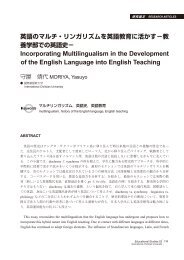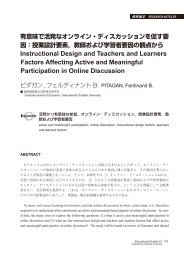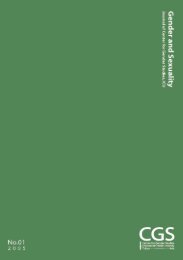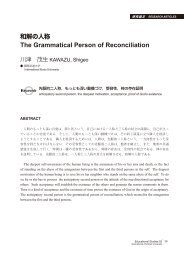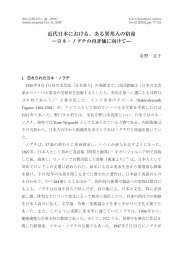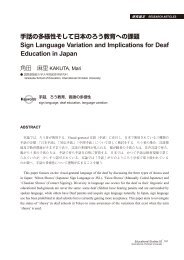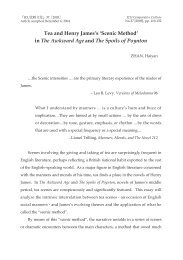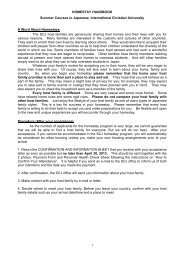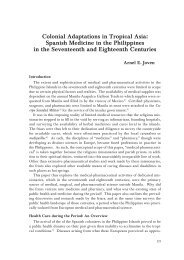The Culture of Music and Ritual in Pre-Han Confucian - subsite
The Culture of Music and Ritual in Pre-Han Confucian - subsite
The Culture of Music and Ritual in Pre-Han Confucian - subsite
You also want an ePaper? Increase the reach of your titles
YUMPU automatically turns print PDFs into web optimized ePapers that Google loves.
le leaders <strong>and</strong> s<strong>in</strong>gers. 37) Among Baroque s<strong>in</strong>gers <strong>and</strong> musicians, the Canadians<br />
(<strong>in</strong>clud<strong>in</strong>g Angela Hewitt, Kar<strong>in</strong>a Gauv<strong>in</strong>, <strong>and</strong> Marie-Nicole Lemieux) have become<br />
<strong>in</strong>creas<strong>in</strong>gly prom<strong>in</strong>ent on the world stage, <strong>and</strong> as a Canadian this is a matter <strong>of</strong> personal<br />
pride. I also spent some years learn<strong>in</strong>g to love Indian classical music back <strong>in</strong><br />
the golden days <strong>of</strong> Ravi Shankar <strong>and</strong> Ali Akbar Khan, <strong>and</strong> as far as time permits I<br />
hope to delve more <strong>in</strong>to Ch<strong>in</strong>ese, Korean <strong>and</strong> Japanese traditional music as well.<br />
<strong>The</strong> readers <strong>of</strong> this essay undoubtedly have their own rather different sets <strong>of</strong> culture<br />
heroes, but the po<strong>in</strong>t is, while the particular forms may differ, the underly<strong>in</strong>g spirit<br />
<strong>and</strong> purpose are the same: reawaken<strong>in</strong>g the present generations to the <strong>in</strong>credibly<br />
rich musical heritage <strong>of</strong> the past, especially the long-submerged traditions dat<strong>in</strong>g<br />
from before the 19th century. Ideally it would be nice to found an organization or<br />
newsletter called “<strong>Confucian</strong> <strong>Culture</strong> <strong>and</strong> <strong>Music</strong>,” or just “<strong>Pre</strong>modern <strong>Music</strong>al <strong>Culture</strong><br />
East <strong>and</strong> West,” but I cannot afford the time to do such a project on my own.<br />
Communication through exist<strong>in</strong>g magaz<strong>in</strong>es <strong>and</strong> scholarly essays that sometimes<br />
engage one another is probably sufficient. If some <strong>of</strong> the great revivalist musicians<br />
come <strong>in</strong> contact with the traditional <strong>Confucian</strong> theory <strong>of</strong> music, such as by read<strong>in</strong>g<br />
the present essay, I hope that it will help charge them with the conviction that the<br />
welfare <strong>of</strong> mank<strong>in</strong>d <strong>and</strong> the very harmony <strong>of</strong> the universe depend on the quality <strong>of</strong><br />
their play<strong>in</strong>g, that there is noth<strong>in</strong>g more important they could do with their talents<br />
<strong>and</strong> time than what they are already do<strong>in</strong>g–complet<strong>in</strong>g their characters through<br />
music <strong>and</strong> help<strong>in</strong>g others to do the same. Only play<strong>in</strong>g performed with such conviction<br />
can deeply move the audience, <strong>and</strong>, through the audience, make the world <strong>in</strong>to<br />
a more peaceful, civil <strong>and</strong> joy-filled place. It would be nice if some readers skilled <strong>in</strong><br />
draw<strong>in</strong>g would send me a couple <strong>of</strong> portraits <strong>of</strong> Confucius that portray him as a musician<br />
enjoy<strong>in</strong>g tak<strong>in</strong>g his “recreation <strong>in</strong> the arts” out <strong>in</strong> the open fields, depict<strong>in</strong>g<br />
him as much less <strong>of</strong> a stuffy old guy than the traditional <strong>of</strong>ficial portraits, which<br />
were symbols <strong>of</strong> Ch<strong>in</strong>ese <strong>of</strong>ficial orthodoxy. Remember that Confucius was not always<br />
an old man with a beard <strong>and</strong> a long robe! <strong>The</strong>se radical portraits <strong>of</strong> Confucius<br />
would be prime c<strong>and</strong>idates for the covers <strong>of</strong> our first few newsletters, if we can ever<br />
pool our energies to produce one! Or for those to whom the very idea <strong>of</strong> Confucius<br />
is just too <strong>in</strong>corrigibly stuffy, maybe a composite draw<strong>in</strong>g <strong>of</strong> a couple <strong>of</strong> premodern<br />
Western <strong>and</strong> Eastern musical <strong>in</strong>struments would do the trick. <strong>The</strong> eyes lead the way<br />
to the ears.<br />
Whether or not my readers have any <strong>in</strong>terest <strong>in</strong> such dreamy projects, I hope that<br />
the present essay has helped opened their eyes to the depth <strong>of</strong> the ancient Ch<strong>in</strong>ese<br />
philosophy <strong>of</strong> music, <strong>and</strong> will motivate them to look further <strong>in</strong>to the riches that this<br />
tradition has to <strong>of</strong>fer. I believe that the the Ch<strong>in</strong>ese tradition, the Indian tradition,<br />
the Western tradition <strong>and</strong> the Islamic tradition can all agree that it is music–especially<br />
sacred <strong>and</strong> classical music–that completes the cultivation <strong>of</strong> our character,<br />
aided by a reasonable dose <strong>of</strong> ritual directed at a realm beyond the present material<br />
world. Thus I believe we are justified <strong>in</strong> tak<strong>in</strong>g the Yueji beyond its traditional East<br />
Asian context <strong>and</strong> <strong>in</strong>troduc<strong>in</strong>g it as a contributory voice for the newly evolv<strong>in</strong>g subculture<br />
<strong>of</strong> cross-cultural music <strong>and</strong> cross-cultural spirituality. <strong>The</strong> portraits I am<br />
wait<strong>in</strong>g for will have a rather young-look<strong>in</strong>g Confucius play<strong>in</strong>g a sitar (à la Ravi<br />
Shankar), play<strong>in</strong>g a Renaissance lute (à la Paul O’Dette 38) ), play<strong>in</strong>g a dulcimer, play-<br />
120



